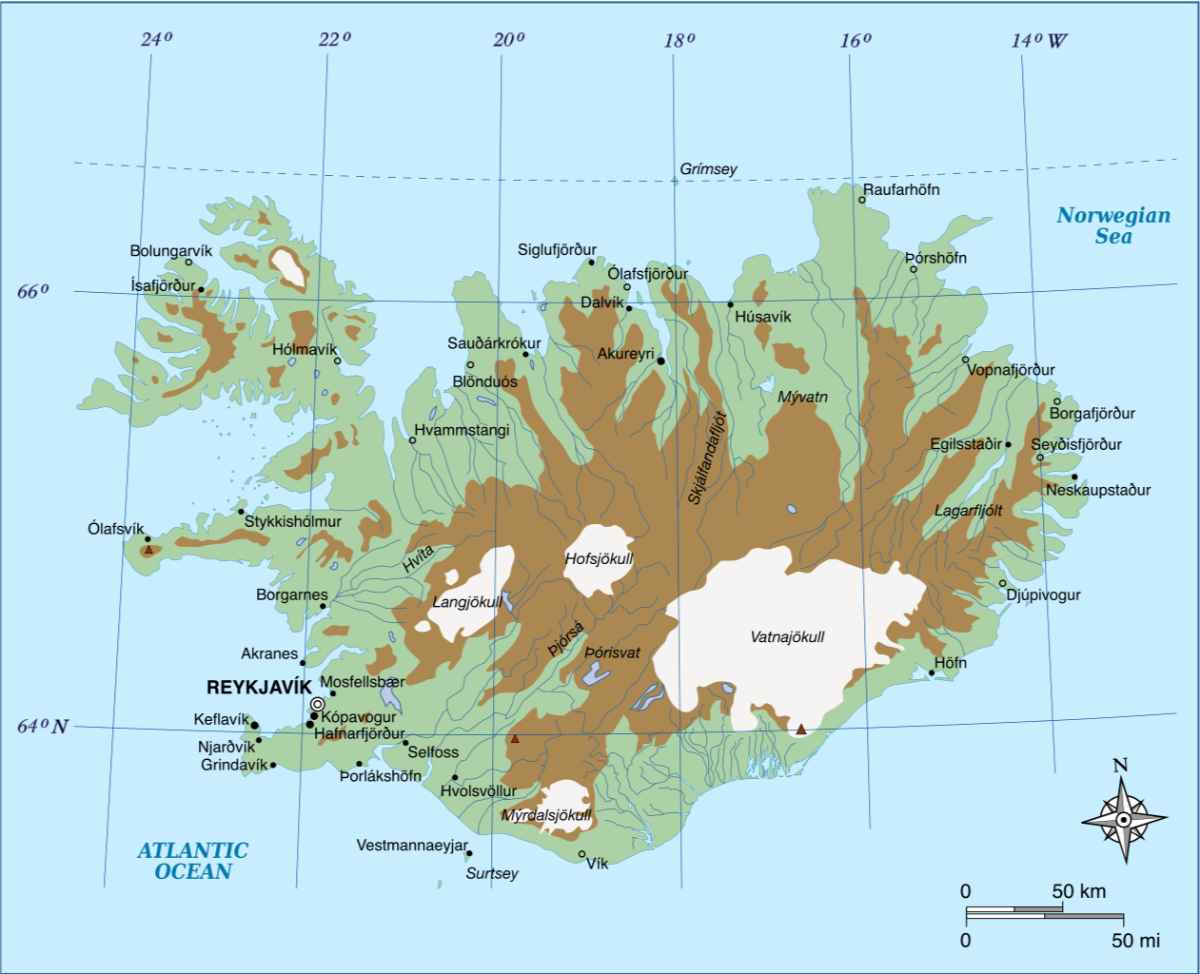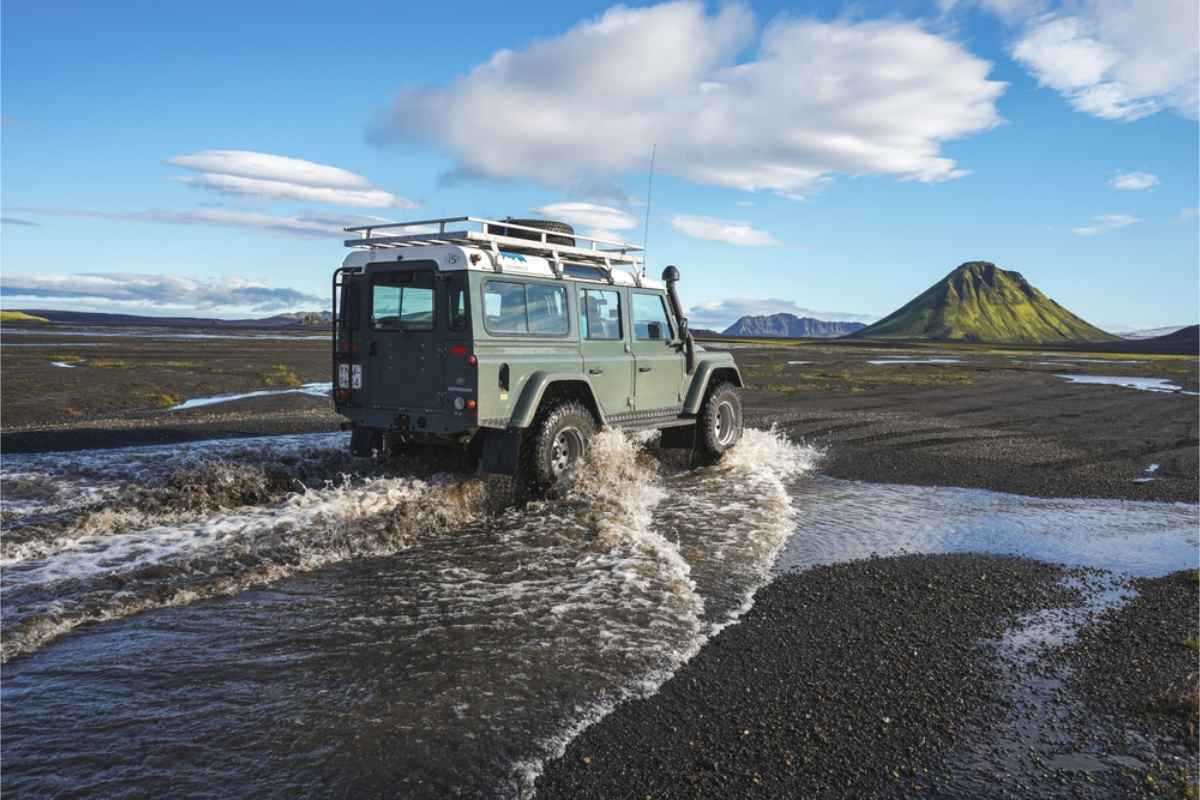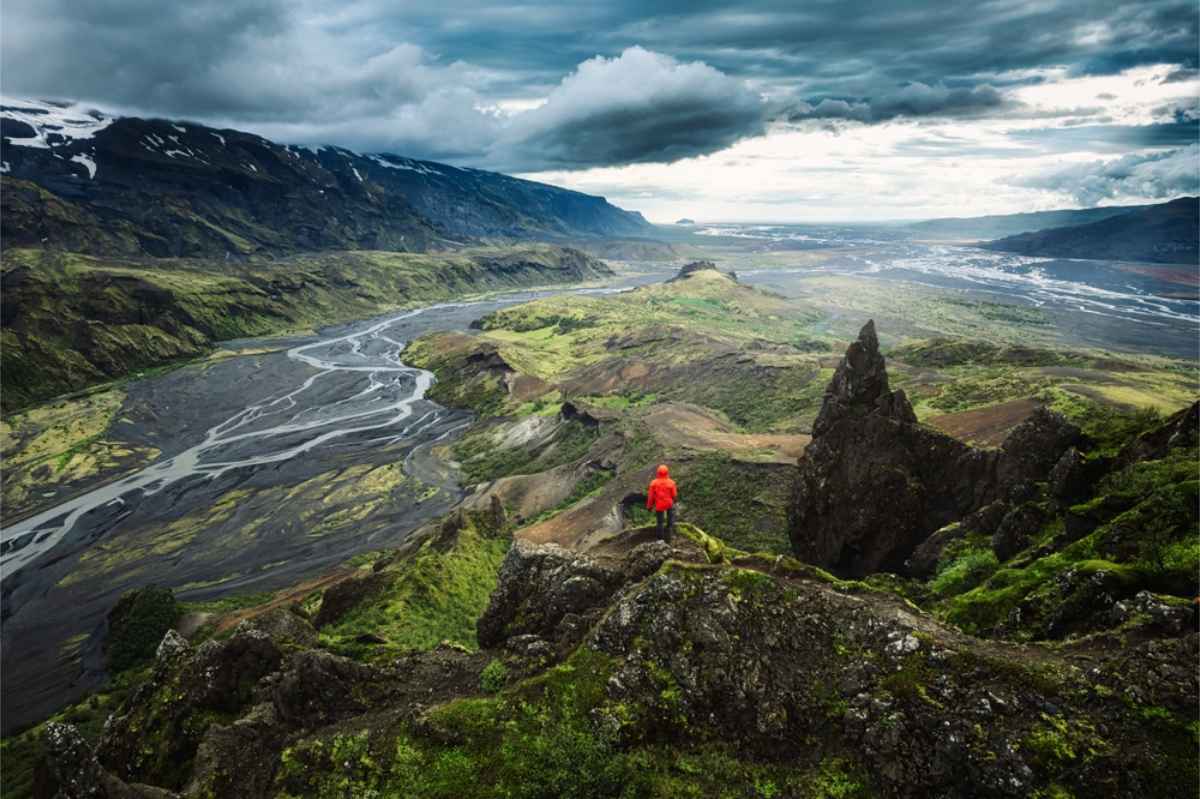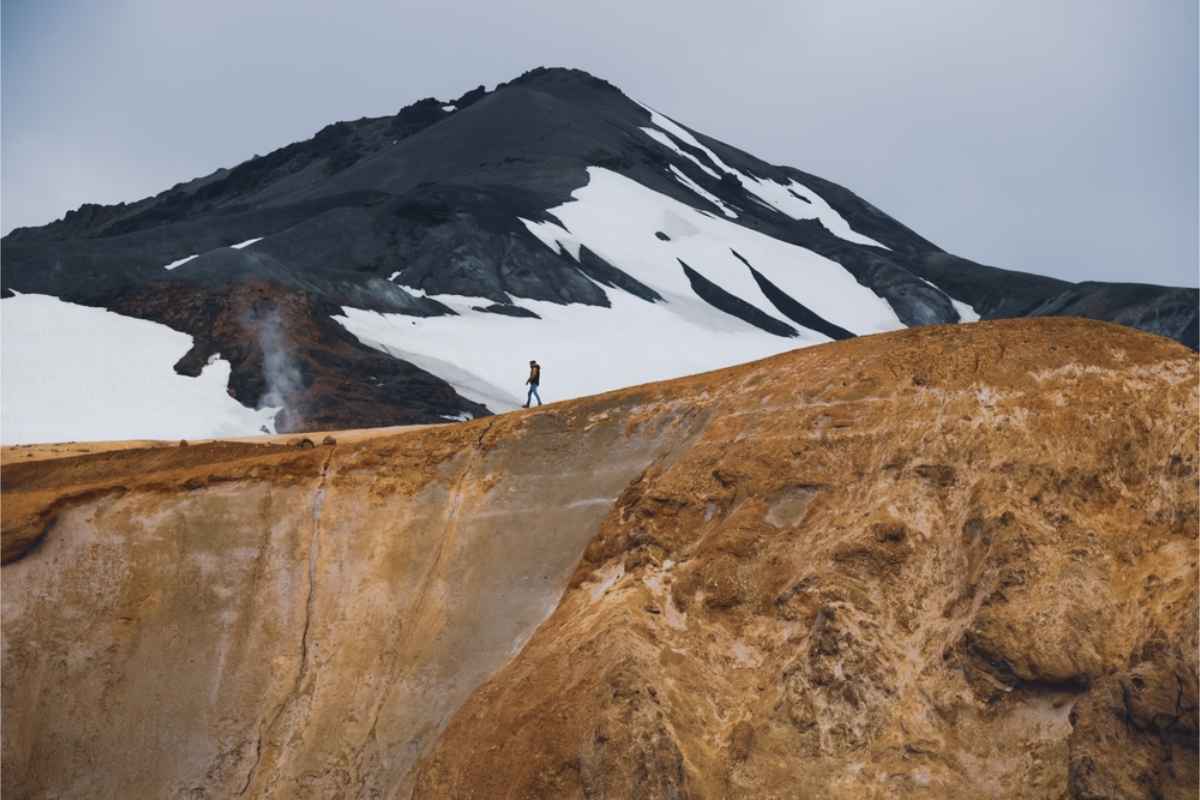Iceland’s Highlands are the raw heart of the country, wild and untamed, with no shortcuts and no hand-holding. This guide is built for people in campers who can read a map, handle gravel, and pack smart.
You’ll get the essentials that matter: when to go, which wheels survive the F-roads, what to pack, and how to camp without hassle. The Highlands won’t spoon-feed you. Roads are rough, services vanish, weather flips fast, and the rules on driving are strict enough to sting if you ignore them.
What Are the Icelandic Highlands?
The highlands of Iceland swallow close to 40% of the island, roughly 40,000 square kilometers (15,400 square miles). It’s one of the largest uninhabited wilderness areas in Europe, a central plateau cut with volcanic deserts, glacial tongues, and endless gravel F-roads.
The scenery is nothing short of breathtaking. Rhyolite peaks shift color with every cloud. Black sand plains stretch as far as the eye can see. Steam hisses from the ground. Canyons slice through lava fields.
Where Are the Highlands in Iceland?
They sit in the central interior. No towns, barely any services, and hardly any directional signage. Maps lie about distance. An hour’s drive turns into three. Believe us when we tell you that this place is nothing like the Ring Road.

When Is the Best Time to Visit?
The highlands in Iceland don’t play by the calendar. Mid-June to early September is the window. That’s it. Roads open when they’re safe. They close when they’re not. No guarantees.
June throws you endless daylight, up to 20-22 hours, with snow still hanging around. July is peak access and peak crowds, with daylight around 18-20 hours. August steadies out, 15-18 hours, until rivers rise and test your nerves. September drops fast to 12-14 hours. Nights? Cold in every single month.
- June - 5-12°C (41-54°F)
- July - 8-15°C (46-59°F)
- August - 7-13°C (45-55°F)
- September - 3-10°C (37-50°F)
Nights stay cold in every month. If your entire plan depends on a gate opening on your exact date, make another plan. Want fewer people in your photos? Go midweek. Start early. Pick one hidden valley instead of chasing the same spots everyone else geotagged yesterday.
Why Explore by Campervan?
If you plan to rent a campervan in Iceland, the Highlands make the case for it. A camper means independence from towns, timetables, and expensive guesthouses. You carry your bed, your stove, and your gear wherever the F-roads take you.
That freedom lets you chase weather windows, swap routes when conditions shift, and stretch an Icelandic Highlands itinerary without doubling back. The cost side matters too. Fewer restaurant stops save money.
Avoiding long detours back to town saves fuel and hours. For those who want flexibility, comfort, and control in the middle of nowhere, a camper is the only real option.
Advantages of a Camper in the Highlands
Once you’re on the plateau, the small wins add up.
- Sleep strategy - Park at trailheads. Step out at sunrise.
- Drying zone - Rotate gear, keep boots functional, stay ready for day two.
- Power habits - Charge while driving. Carry a backup so devices never quit.
- Photography life - Stay parked until the light shifts, then move when it counts.
- Solo vs crew - Assign zones. Gear here, cooking there, sleep space clear. Cut down chaos before it grinds patience.

Freedom vs Accessibility: What You Need to Know
The highlands of Iceland give you space to roam, but not without rules. F-roads are restricted, and many require real clearance with a proper 4WD. Forget off-track driving. Closed roads stay closed. Even bridges have weight and width limits that matter when you rent a campervan.
Smart route design means carrying more than one plan. Build A, B, and C itineraries that shift with weather and river levels. A sudden storm can turn a passable ford into a no-go in hours. Vehicles have limits, too. Match your route to the clearance, tires, and drivetrain you actually rented, not the one you wish you had.
Distances also stretch. Gravel roads can double the time your city brain imagines. You have options. The Highlands also have opinions. Respect them, and the trip rewards you. Ignore them, and you’ll be waiting for a tow truck instead of a sunset.
Do You Need a 4x4 Camper?
For meaningful access to Iceland’s Highlands, the answer is yes. A 2WD camper can handle paved routes and certain gravel approaches in good conditions, but once a road turns into an F-road, the rules change. F-roads are strictly 4x4 territory, no exceptions.
Here’s where travelers get tripped up. Some roads begin as normal gravel but then transform into F-roads halfway through. Road 26 toward Landmannalaugar is the classic example: smooth enough at first, then suddenly, F26, rough and punishing. Road 35 up to Gullfoss? Easy gravel. Beyond that? F-road conditions, even if the surface looks “better” thanks to recent upgrades.
As a rule of thumb, 2WD is fine for short gravel stretches on the edge of the Highlands, but if your plan takes you anywhere beyond the obvious stops, book a 4x4. Better safe than sorry. The Highlands punish ‘just a bit further.’
Understanding F-Roads and River Crossings
The highlands in Iceland are only open to 4x4 vehicles. Regular campers are not allowed on F-roads, and for good reason. These are rugged mountain tracks built of rough gravel, with washboards, blind crests, and river fords that demand focus.
River crossings are the hardest part. The safest time is usually morning, when water levels sit lower. Always check first. Walk the ford if it’s safe, unbuckle your seat belt, and cross with a low, steady throttle to hold momentum without speeding.
If you cannot see depth or flow, do not cross. Silt hides rocks, steps, and deep holes. Look for braided shallows, not the deepest V. Vehicle tracks often point to safer lines, and if another 4x4 crosses, watch closely.
The golden rule: ego is not a snorkel. Turn back if it looks wrong. Highland buses and super-jeep tours exist for the routes that overwhelm.

Rental Insurance Considerations
Campervan rental insurance is not small print in the Highlands, it’s survival. Our vehicles include CDW Insurance and Third Party Liability as standard. CDW is all-risk coverage, limiting bodywork costs, but exclusions still apply depending on make or model. Ask us directly if you want the fine print spelled out. Iceland is safe, but accidents still happen.
Step up to Premium Insurance and you add SCDW, Gravel Protection (GP), Theft Protection (TP), and Sand and Ash Protection (SAAP). Deductibles vary, and keep in mind this plan does not cover tires, underbody, river damage, or off-road mishaps.
Want the easy button? Platinum Insurance reduces your liability to zero. It covers collision, gravel, sand, and ash damage. Zero excess. No stress. Whatever you choose, remember trackers exist, and tow bills in Iceland are brutal. For a better understanding of rental insurance, here is a table that will help you make an informed decision:
|
Insurance Type |
What’s Included |
What’s Not Covered |
Who It’s For |
|
CDW + Third Party Liability(included) |
All-risk coverage for bodywork, liability protection. |
Tires, underbody, river damage, off-road driving. Specifics vary by make/model. |
Every renter. Basic safety net. |
|
Premium Insurance |
CDW, SCDW, Gravel Protection (GP), Theft Protection (TP), Sand & Ash Protection (SAAP). |
Tires, underbody, river damage, off-road driving. Deductible still applies. |
Travelers who want broad cover but can handle some risk. |
|
Platinum Insurance(Zero Excess) |
Everything in Premium. Zero liability for collision, gravel, sand, and ash damage. |
Same exclusions: tires, underbody, rivers, off-road. |
Anyone who wants full peace of mind and no deductible. |
Pro tips:
- Photograph your camper at pickup and drop-off.
- Confirm allowed roads in writing.
- Save roadside numbers.
- Trackers exist. Towing bills in Iceland are long and expensive.
Essential Packing List for Highland Travel
Packing for the Highlands is about survival, not souvenirs. Gear keeps you moving, warm, and sane when the weather turns. Here is what you should not forget:
|
Category |
What to Bring |
|
Vehicle kit |
Reflective vest, warning triangle, tow strap, compact shovel, work gloves, duct tape, zip ties |
|
Navigation |
Offline maps loaded, paper map backup, headlamp with spare batteries |
|
Clothing |
Base layers, insulating mid, waterproof shell, warm hat, gloves, spare dry socks |
|
Footwear |
Waterproof boots with grip, camp shoes for morale |
|
Sleep system |
Rated sleeping bags, liner, eye mask for bright nights, earplugs for wind |
|
Kitchen |
Fuel that fits your stove, windscreen, lighter + matches, quick-cook meals, insulated mug |
|
Water & fuel |
Extra water container, plan driving range, never enter remote sections low on fuel |
|
Comms & power |
High-capacity power bank, 12V chargers, optional PLB or satellite messenger |
|
First aid |
Blister care, pain relief, elastic wrap, personal medications |
|
Nice-to-haves |
Microfiber towel, sit pad, silica packs for camera gear, trash bags for pack-in/pack-out |
Top Destinations in the Highlands
The Highlands are huge, but a handful of places define the experience. These are the valleys, mountains, and geothermal fields worth building your trip around.
Landmannalaugar
Landmannalaugar belongs on any highlands itinerary in Iceland. The rhyolite mountains here don’t just sit still. Colors shift with the light, sharp and obvious.
Hiking is the reason most come. Loops for beginners. Long climbs for the stubborn. Every trail gives you views that pay off. After the dust, a hot spring waits right by camp. Natural, simple, hot.
Getting there is not one road. F208 South is beautiful but full of river fords. Only a 4x4 belongs on it. F208 North cuts the rivers but still rattles with rough gravel. F225 from the west is easier and the route most campers use.
Beat the buses. Start at sunrise. Stay on marked trails. If it feels too crowded, nearby valleys carry the same colors without the noise. One last note: the pool smells of sulphur. Egg scent included. Bliss included, too.
Popular Hiking Trails in Landmannalaugar
|
Trail |
Distance |
Difficulty |
Est. Time |
|
Bláhnúkur and Brennisteinsalda |
10.8 km (6.7 mi) |
Hard |
~4h 10m |
|
Laugahringur (Laugahraun Tour) |
4.7 km (2.9 mi) |
Moderate |
~1h 20m |
|
Bláhnúkur |
6.1 km (3.8 mi) |
Hard |
~2h 25m |
|
Laugavegur Trail |
10.3 km (6.4 mi) |
Hard |
~3h 20m |
|
Brennisteinsalda Loop |
9.3 km (5.8 mi) |
Hard |
~3h 30m |
Kerlingarfjöll
Kerlingarfjöll tops out at 1,477 m (4,846 ft) and owns its place in the Highlands. Steam cuts through snowfields, ridgelines bend in sharp angles, and the whole massif feels wired with geothermal heat. Access comes by the Kjölur route (F35). Summer only. The weather turns fast at this altitude, so don’t roll in blind.
The hook here is hiking. Short 1 km walks through boiling valleys. Medium circuits that stack color and steam. The 7 km climb up Snækollur is the headliner, with views across the plateau that remind you why you dragged boots this far.
Best play: pick one marquee route and actually give it time. Let the camera breathe. If conditions shut you down, slide over to Hveravellir. Boardwalks, hot pools, still worth the drive. Kerlingarfjöll pays off for the prepared. For the rest, it’s just another mountain they never really saw.
Popular Hiking Trails in Kerlingarfjöll
|
Trail |
Distance |
Difficulty |
Est. Time |
|
Ásgarður – Hveradalir |
11.7 km (7.3 mi) |
Moderate |
4h |
|
Hveradalir Loop |
3.5 km (2.2 mi) |
Moderate |
1h 20m |
|
Fannborg |
7.4 km (4.6 mi) |
Hard |
2h 50m |
|
Snækollur Kerlingarfjöllum |
6.4 km (4.0 mi) |
Hard |
3h |
|
Mt. Ásgarðsfjall from Ásgarður |
2.7 km (1.7 mi) |
Moderate |
1h 15m |
Askja
Askja is one of the raw giants of the highlands of Iceland, a volcanic caldera that feels closer to the Moon than Earth. The floor sits around 1,100 m (3,609 ft), with rim edges reaching up to 1,500 m (4,921 ft). At the center waits Víti, a crater lake framed by jagged volcanic walls and ash fields that stretch into the horizon.
Reaching it takes commitment. River crossings and locked gates are part of the deal. Even in midsummer, snow patches often linger on the trail to the crater viewpoints. If conditions block access, canyon systems along the way back give you a worthy alternative.
NASA even trained Apollo astronauts here in the 1960s because the terrain so closely resembled the lunar surface. Every view at Askja has to be earned, and that is exactly why it’s unforgettable.
Hiking Trail in Askja
|
Trail |
Distance |
Difficulty |
Est. Time |
|
Askja Crater Trail |
6.4 km (4.0 mi) |
Moderate |
1h 35m |
Thórsmörk
Thórsmörk sits in a pocket between Eyjafjallajökull, Mýrdalsjökull, and Tindfjallajökull. A valley carved by ice, dripping with moss, and scattered with small birch forests. It is one of the few corners of the Highlands that actually feels alive.
The contrast hits quickly. Barren gravel outside, green shelter inside. That’s the appeal. Getting there is not casual. Glacier rivers block the way, and they don’t forgive mistakes.
Once in, the trick is to slow down. Pick one marquee hike and actually finish it. Ridges and forests give plenty without trying to tick off three trails in a day. If the rivers rise on your exit, park at the last safe spot and wait it out, or hop the bus.
Hiking Trails in Thórsmörk
|
Trail |
Distance |
Difficulty |
Est. Time |
|
Þórsmörk - Skógar |
23.8 km (14.8 mi) |
Hard |
Full day (8-10h) |
|
Volcano Huts - Orange Loop |
12.9 km (8.0 mi) |
Moderate |
4-5h |
Sigöldugljúfur Canyon
Sigöldugljúfur, often called the ‘Valley of Tears,’ is one of the quieter gems in the Highlands. Turquoise water weaves through black volcanic rock, spilling over mossy cliffs in thin waterfall curtains. The scale is small compared to the big valleys, but the colors and contrasts feel unreal.
Getting there takes effort. Pull into marked stops and stay clear of the fragile canyon edges. Once parked, a short hike leads to several viewpoints. The wind funnels hard here, so carry a layer even in midsummer.
Crowds rarely gather, which gives you time to linger and take it in. If conditions shift, other nearby highland vistas carry the same palette of blue water and dark stone.
Hiking Trail in Sigöldugljúfur
|
Trail |
Distance |
Difficulty |
Est. Time |
|
Sigöldugljúfur Canyon Viewpoints |
1.9 km (1.2 mi) |
Easy |
30 min |
Hveravellir
Hveravellir sits high in the Icelandic Highlands, between Langjökull and Hofsjökull glaciers at about 650 m (2,133 ft). It is a geothermal reserve where steam pushes through vents, mud bubbles in shallow pools, and a sky-blue hot spring waits for a slow soak.
Getting there means taking the Kjölur route (F35). It is one of the easier Highland roads, but the gravel is rough, and the washboard sections test both driver and vehicle. Once on-site, the rhythm is simple.
Walk the boardwalks through the steaming ground, sit back in the pool, and stay late enough to watch the sky stretch wide. If the weather turns, nearby viewpoints still give you the big Highland panorama without wasting the trip.
Popular Hiking Trails in Hveravellir
|
Trail |
Distance |
Difficulty |
Est. Time |
|
Green Trail – Eyvindarrétt Circle |
3 km (1.9 mi) |
Easy |
30-40 min |
|
Red Trail – Hveravellir to Strýtur and back |
12 km (7.5 mi) |
Moderate |
3-4 h |
|
Orange Trail – Hveravellir to Þjófadalir and back |
21 km (13 mi) |
Moderate/Hard |
4-5 h |
Laugavallalaug & Hafrahvammagljúfur
Deep in the Highlands sit two very different rewards. Laugavallalaug is a pocket-sized hot spring where a naturally heated waterfall drops into a pool just big enough to stretch out tired legs. It feels remote because it is. Getting here means hours on gravel F-roads. Nothing casual about the drive.
Close by, Hafrahvammagljúfur opens up. A massive canyon with volcanic cliffs cut into layers and ridges that look endless. Trails here are rugged, built for slow steps and long pauses with a camera. The scale is the point.
The rhythm works best if you keep it simple. Soak in the warm water, hike into the canyon, and leave before the evening weather flips. If time is short or conditions get messy, choose one. Do it properly instead of rushing both.
Where to Camp in the Highlands
Campsites in the Highlands are very basic. Some offer toilets, perhaps cooking facilities, and maybe a shower. But don’t count on all of them having drinking water. Pick shelter from the wind over the perfect view, because gusts at 3 a.m. ruin sleep. Pay your fee, park on hardened ground, and keep noise down.
Thin camper walls aren’t exactly soundproof, you know. Carry out trash, dump grey water properly, and never treat the tundra as your bathroom. Wild camping is tightly regulated, so only stop where it’s permitted, stay brief, and vanish without a trace. For safety, park nose-out, check the wind, and avoid soft shoulders or riverbeds that swallow tires.

Safety Tips for Driving and Staying
For the love of Odin, safety should be your top priority when exploring the Highlands, so please don’t skim over this section. Here is some expert advice from us on how to keep safe while still enjoying this remote wilderness:
Weather and Road Conditions
Icelandic weather changes fast, so use vedur.is for forecasts and umferdin.is for road updates every morning and again after lunch. Gravel roads punish mistakes: slow down, brake earlier, and expect washboard ruts.
Fog and dust can erase visibility in seconds, so stop somewhere safe and wait it out. Winds are another beast, often hitting 20-30 m/s (45-67 mph) in exposed areas. Park into the gusts, hold doors with both hands, and secure loose gear. We’ve seen winds rip off people’s doors in the past, and it is more common than you might think.
Rivers swell with afternoon snowmelt and heavy rain. If a crossing looks deeper than it should, wait or reroute.
Fuel, Food, and Navigation Advice
In Iceland’s Highlands, you plan by stations, not by gut. Never start a remote stretch with less than half a tank. Fuel pumps sit in towns and along main roads. None exists deep inside.
Stock food before leaving civilization, and always keep a 24-hour meal reserve. Carry more water than you think you need and refill at every chance. Navigation requires layers: GPS with offline maps, a paper backup map, downloaded maps from Maps.me on your mobile, a charged phone, and a headlamp for reading in the dark.
If trouble comes, stay with the vehicle and signal. Rescuers find vans easier than lost hikers.

Staying Connected and Emergency Contacts
The Highlands are not wired. Expect dead zones and warn someone of your plan and return time before leaving signal. For longer or solo trips, a satellite messenger is smart. It sends check-ins even when the phone is useless.
The national emergency number is 112, and SafeTravel.is links directly to it through their app. Learn how to share simple location cues, for example, road numbers, landmarks, and GPS points, so help knows where to find you. Register your travel plan at SafeTravel.is before heading out.
Sample 3-Day Highland Itinerary by Camper
Planning an Icelandic Highlands itinerary means balancing road time with adventure. Here’s the route we recommend you take:
Day 1 - Landmannalaugar
- Drive: Reykjavík to Landmannalaugar via F208, about 180 km (112 mi), 4-5h depending on road and ford conditions.
- Plan: Arrive by late morning. Pick a shorter hike like Bláhnúkur or Laugahringur (2-4h). End the day with a soak in the hot spring. Stay overnight nearby or at the campsite.
Day 2 - Landmannalaugar to Kerlingarfjöll
- Drive: Around 250 km (155 mi), 4-5h minimum. F-roads are slow, expect washboards and possible fords.
- Plan: Settle into Kerlingarfjöll in the afternoon. Choose one marquee loop, such as the Snækollur summit or Hveradalir geothermal area. Overnight in the campsite.

Day 3 - Kerlingarfjöll to Hveravellir and exit
- Drive: 70 km (43 mi), 1.5-2h on the Kjölur (F35). Continue north to the Ring Road afterward.
- Plan: Explore the geothermal fields at Hveravellir, walk the boardwalks, and soak in the pool. Leave with enough daylight and fuel to reach your next town.
Final Tips for a Highland Camper Adventure
|
Tip |
What It Means |
|
Prepared beats brave |
Skills matter more than guts. Do your checks, carry spare layers, and plan for weather swings. |
|
Vehicle-first thinking |
Match your route to what your camper can actually handle: wheelbase, tires, and clearance decide, not your bucket list. |
|
Common rookie mistakes |
Don’t chase closed roads. Avoid packing too heavy or forgetting warm gear. Start drives early instead of rolling out at noon. |
|
Rental housekeeping |
Top up fuel before every remote leg. Take photos of the van at pickup and return. Report issues early to avoid blame later. |
Travel Free in the Icelandic Highlands
The Icelandic Highlands are not for guessing. They are for planning, and for those who bring the right wheels and the right mindset. Book a 4x4 camper early and tell the rental you are going into the Highlands.
With a proper vehicle and a plan, this trip will be the best of your year. The next step is simple. Check availability. Sketch out a couple of routes for just in case plan A does not work out.
Build your packing list. The rest is waiting out there. Confident drivers get freedom. The Highlands repay preparation with wild beauty that no shortcut or last-minute gamble will ever match.


 By
By


